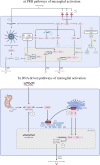The Hallmarks of Ageing in Microglia
- PMID: 40389766
- PMCID: PMC12089641
- DOI: 10.1007/s10571-025-01564-y
The Hallmarks of Ageing in Microglia
Abstract
As ageing is linked to the development of neurodegenerative diseases (NDs), such as Alzheimer's Disease and Parkinson's Disease, it is important to disentangle the independent effect of age-related changes from those due to disease processes. To do so, changes to central nervous system (CNS) cells as a function of advanced age need better characterisation. Microglia are of particular interest due to their proposed links with the development and progression of NDs through control of the CNS immune response. Therefore, understanding the extent to which microglial dysfunction is related to phyisological ageing, rather than a disease process, is critical. As microglia age, they are believed to take on a pro-inflammatory phenotype with a distinct dystrophic morphology. Nevertheless, while established hallmarks of ageing have been investigated across a range of other cell types, such as macrophages, a detailed consideration of functional changes that occur in aged microglia remains elusive. Here, we describe the dynamic phenotypes of microglia and evaluate the current state of understanding of microglial ageing, focusing on the recently updated twelve hallmarks of ageing. Understanding how these hallmarks present in microglia represents a step towards better characterisation of microglial ageing, which is essential in the development of more representative models of NDs.
Keywords: Ageing; Immunosenescence; Inflammageing; Microglia; Morphology; Neuroinflammation.
© 2025. The Author(s).
Conflict of interest statement
Declarations. Competing interests: The authors declare no competing interests.
Figures




References
-
- Ajami B, Bennett JL, Krieger C, Tetzlaff W, Rossi FMV (2007) Local self-renewal can sustain CNS microglia maintenance and function throughout adult life. Nat Neurosci 10(12):1538–1543. 10.1038/nn2014 - PubMed
-
- Alliot F, Godin I, Pessac B (1999) Microglia derive from progenitors, originating from the yolk sac, and which proliferate in the brain. Brain Res Dev Brain Res 117(2):145–152. 10.1016/s0165-3806(99)00113-3 - PubMed
-
- Ames BN, Atamna H, Killilea DW (2005) Mineral and vitamin deficiencies can accelerate the mitochondrial decay of aging. Mol Aspects Med 26(4):363–378. 10.1016/j.mam.2005.07.007 - PubMed
Publication types
MeSH terms
LinkOut - more resources
Full Text Sources
Medical
Research Materials

